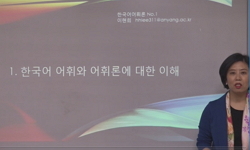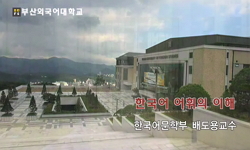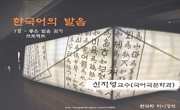A Study on the Colloquial Korean Sentence of Students from Vietnam and China The purpose of this study is to examine the relationship between the complexity and diversity of colloquial sentences, and to see how they change based on the proficiency ...
http://chineseinput.net/에서 pinyin(병음)방식으로 중국어를 변환할 수 있습니다.
변환된 중국어를 복사하여 사용하시면 됩니다.
- 中文 을 입력하시려면 zhongwen을 입력하시고 space를누르시면됩니다.
- 北京 을 입력하시려면 beijing을 입력하시고 space를 누르시면 됩니다.
https://www.riss.kr/link?id=T14563894
- 저자
-
발행사항
서울 : 한국외국어대학교 대학원, 2017
-
학위논문사항
학위논문(석사) -- 한국외국어대학교 대학원 , 국어국문학과 , 2017. 8
-
발행연도
2017
-
작성언어
한국어
- 주제어
-
DDC
895.1 판사항(22)
-
발행국(도시)
서울
-
기타서명
Study on the colloquial Korean sentence of students from Vietnam and China
-
형태사항
113 p. : 삽도 ; 26 cm
-
일반주기명
한국외국어대학교 논문은 저작권에 의해 보호받습니다.
지도교수: 김의수
참고문헌 : p. 64-67 - 소장기관
-
0
상세조회 -
0
다운로드
부가정보
다국어 초록 (Multilingual Abstract)
The purpose of this study is to examine the relationship between the complexity and diversity of colloquial sentences, and to see how they change based on the proficiency of Korean language students from Vietnam and China; in addition to determining what of the various factors that explain complexity and diversity have an important effect on the development of colloquial Korean sentences by the foreign students.
In order to determine how colloquial sentences develop based on the proficiency of the student, verbal interviews were conducted on 38 Chinese and Vietnamese students who are studying Korean language in formal education institutes in Korea. The analysis of sentences was based on the analysis framework of analytic grammar, and the research was conducted focusing on syntactic/lexical complexity and diversity.
The first research objective was to determine what forms the syntactic complexity and diversity of colloquial sentences appear in based on the proficiency and country of origin of the Korean language students. The results of the first stage analysis of syntactic complexity showed that as proficiency increased both propositional complexity and modality complexity increased by a meaningful amount, and this aspect showed a high interrelationship with embedded clauses. In the case of propositional complexity, while the propositional complexity of Chinese students in all stages from beginner-intermediate-advanced showed increases in propositional complexity, Vietnamese students showed stagnation in the beginner-intermediate stages before showing meaningful increase in propositional complexity in the intermediate-advanced stages. In the case of modality complexity, the complexity score of Chinese students were higher than Vietnamese students in all stages from beginner-intermediate-advanced, and especially showed a meaningful increase differences in the intermediate-advanced stages. That is, we found that compared with Vietnamese students, students from China spoke with more syntactically complex sentences as their proficiency increased. The results of the second stage syntactic diversity analysis showed that regardless of proficiency or country of origin, students produced sentences in the order of [AE]->[ABE]/[ACE]->[ABCE]->[ACCE]. In addition, the most dominant form, regardless of matrix clauses or embedded clauses and regardless of proficiency, was shown to be [AE] or [AEE] by which we can see that the most simple sentences were being used the most.
The second research objective was to determine in what form lexical complexity and diversity of colloquial sentences appeared based on the proficiency and country of origin of the Korean language students. The results of the first stage analysis on lexical complexity showed that as proficiency increased the complexity of vocabulary types(parts of speech) and complexity of vocabulary class all increased by meaningful differences, and that as with syntactic complexity this also showed a high interrelationship with embedded clauses. Especially in the case of Chinese advanced students, they averaged 4 points higher in the complexity of vocabulary type(parts of speech) compared to Vietnamese students, and also showed about 40 points difference in highest score. We estimate that this is due to the fact that Chinese students are more easily able to use advanced hanja vocabulary that are shared in China and Korea than Vietnamese students. The results of the second stage lexical diversity analysis showed that regardless of the proficiency or country of origin of the students, they produced the forms of [WZ]/[VZ], [GVZ]/[GKZ], [GVKZ]/[GWKZ] the most.
The last research objective was to determine the relationship between syntactic complexity and lexical complexity. The results of correlation analysis showed that propositional complexity, modality complexity, complexity of vocabulary type(parts of speech), vocabulary class complexity all showed close interrelationships. We were able to determine that the interrelationships between propositional complexity, modality complexity, and complexity of vocabulary type(parts of speech) were especially high.
So far, this study has analyzed the colloquial sentences of Vietnamese and Chinese students from syntactical and lexical perspectives based on analysis framework of analytic grammar. Through this we determined that the internal factor that could explain the colloquial proficiency of the student was embedded clauses, and external factors were propositional/modality/vocabulary type complexity. We hope that the contents of this study can in some way contribute to the development of the future research on colloquial language of Korean language students.
A Study on the Colloquial Korean Sentence of Students from Vietnam and China
The purpose of this study is to examine the relationship between the complexity and diversity of colloquial sentences, and to see how they change based on the proficiency of Korean language students from Vietnam and China; in addition to determining what of the various factors that explain complexity and diversity have an important effect on the development of colloquial Korean sentences by the foreign students.
In order to determine how colloquial sentences develop based on the proficiency of the student, verbal interviews were conducted on 38 Chinese and Vietnamese students who are studying Korean language in formal education institutes in Korea. The analysis of sentences was based on the analysis framework of analytic grammar, and the research was conducted focusing on syntactic/lexical complexity and diversity.
The first research objective was to determine what forms the syntactic complexity and diversity of colloquial sentences appear in based on the proficiency and country of origin of the Korean language students. The results of the first stage analysis of syntactic complexity showed that as proficiency increased both propositional complexity and modality complexity increased by a meaningful amount, and this aspect showed a high interrelationship with embedded clauses. In the case of propositional complexity, while the propositional complexity of Chinese students in all stages from beginner-intermediate-advanced showed increases in propositional complexity, Vietnamese students showed stagnation in the beginner-intermediate stages before showing meaningful increase in propositional complexity in the intermediate-advanced stages. In the case of modality complexity, the complexity score of Chinese students were higher than Vietnamese students in all stages from beginner-intermediate-advanced, and especially showed a meaningful increase differences in the intermediate-advanced stages. That is, we found that compared with Vietnamese students, students from China spoke with more syntactically complex sentences as their proficiency increased. The results of the second stage syntactic diversity analysis showed that regardless of proficiency or country of origin, students produced sentences in the order of [AE]->[ABE]/[ACE]->[ABCE]->[ACCE]. In addition, the most dominant form, regardless of matrix clauses or embedded clauses and regardless of proficiency, was shown to be [AE] or [AEE] by which we can see that the most simple sentences were being used the most.
The second research objective was to determine in what form lexical complexity and diversity of colloquial sentences appeared based on the proficiency and country of origin of the Korean language students. The results of the first stage analysis on lexical complexity showed that as proficiency increased the complexity of vocabulary types(parts of speech) and complexity of vocabulary class all increased by meaningful differences, and that as with syntactic complexity this also showed a high interrelationship with embedded clauses. Especially in the case of Chinese advanced students, they averaged 4 points higher in the complexity of vocabulary type(parts of speech) compared to Vietnamese students, and also showed about 40 points difference in highest score. We estimate that this is due to the fact that Chinese students are more easily able to use advanced hanja vocabulary that are shared in China and Korea than Vietnamese students. The results of the second stage lexical diversity analysis showed that regardless of the proficiency or country of origin of the students, they produced the forms of [WZ]/[VZ], [GVZ]/[GKZ], [GVKZ]/[GWKZ] the most.
The last research objective was to determine the relationship between syntactic complexity and lexical complexity. The results of correlation analysis showed that propositional complexity, modality complexity, complexity of vocabulary type(parts of speech), vocabulary class complexity all showed close interrelationships. We were able to determine that the interrelationships between propositional complexity, modality complexity, and complexity of vocabulary type(parts of speech) were especially high.
So far, this study has analyzed the colloquial sentences of Vietnamese and Chinese students from syntactical and lexical perspectives based on analysis framework of analytic grammar. Through this we determined that the internal factor that could explain the colloquial proficiency of the student was embedded clauses, and external factors were propositional/modality/vocabulary type complexity. We hope that the contents of this study can in some way contribute to the development of the future research on colloquial language of Korean language students.
목차 (Table of Contents)
- 1. 서론 1
- 1.1. 연구 목적 1
- 1.2. 선행 연구 2
- 1.3. 연구 범위 및 방법 5
- 1. 서론 1
- 1.1. 연구 목적 1
- 1.2. 선행 연구 2
- 1.3. 연구 범위 및 방법 5
- 2. 자료 수집과 문장 분석 방법 7
- 2.1. 분석 대상의 선정과 자료 수집 7
- 2.2. 해석문법의 체계 10
- 2.3. 통사적 복잡성과 다양성 산출 방법 11
- 2.4. 어휘적 복잡성과 다양성 산출 방법 17
- 2.5. 데이터에 적합한 통계 분석 방법 선정 21
- 3. 한국어 구어 문장의 통사적 복잡성과 다양성 분석 24
- 3.1. 통사적 복잡성 분석 결과 24
- 3.1.1. 숙달도에 따른 명제적 복잡성 분석 24
- 3.1.2. 출신국에 따른 명제적 복잡성 분석 28
- 3.1.3. 숙달도에 따른 양태적 복잡성 분석 32
- 3.1.4. 출신국에 따른 양태적 복잡성 분석 34
- 3.2. 통사적 다양성 분석 결과 37
- 3.2.1. 숙달도 및 출신국에 따른 명제적 다양성 분석 37
- 3.2.2. 숙달도 및 출신국에 따른 양태적 다양성 분석 39
- 4. 한국어 구어 문장의 어휘적 복잡성과 다양성 분석 41
- 4.1. 어휘적 복잡성 분석 결과 41
- 4.1.1. 숙달도에 따른 어휘 종류의 복잡성 분석 42
- 4.1.2. 출신국에 따른 어휘 종류의 복잡성 분석 44
- 4.1.3. 숙달도에 따른 어휘 등급의 복잡성 분석 47
- 4.1.4. 출신국에 따른 어휘 등급의 복잡성 분석 49
- 4.2. 어휘적 다양성 분석 결과 51
- 4.2.1. 숙달도 및 출신국에 따른 어휘 종류의 다양성 분석 51
- 4.2.2. 숙달도 및 출신국에 따른 어휘 등급의 다양성 분석 54
- 5. 분석의 종합과 해석 56
- 5.1. 문장의 복잡성과 내포문 간의 관계 56
- 5.2. 통사적 복잡성과 어휘적 복잡성 간의 관계 58
- 6. 결론 60
- 참고문헌 64
- ABSTRACT 68












